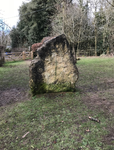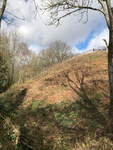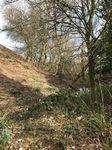Jarn Mound and Wild Garden - UK
>>>Back to Case Studies Overview
>>>Jarn Mound and Wild Garden
| Name | Jarn Mound and Wild Garden | |
| Place | Oxfordshire | |
| Country | United Kingdom | |
| Author(s) | Sophia Clarke | |
| Presentation | https://youtu.be/203QkG6A0To | |
|
| ||
Why is this case relevant?
Jarn Mound is a 50ft high viewpoint (Oxford Preservation Trust, 2016) in Boars Hill, approximately 3 miles from Oxford. The viewpoint was built by Sir Arthur Evans in 1932 (Oxford Preservation Trust, 2016), to allow people to take in the famous view of Oxford and the Berkshire and Wiltshire Downs (Oxford Preservation Trust, 2016). At the top of the mound, there is a plinth with a map of the local area, to allow visitors to locate what they are looking at. The adjoining Jarn Wild Garden contains many different soil types to support a plethora of different British plant species; which Sir Arthur Evans also made open to the public. Sir Arthur Evans was a resident of Boars Hill, and he wanted to preserve the beauty and views of the area (Oxford Preservation Trust, 2016). As a resident of Boars Hill myself, I find this area extremely special and unusual. It is a small piece of Boars Hill's history, and is situated at the heart of the settlement.
Which idea of ‘design with nature’ guides the design concept of this site?
The site was designed and created by Sir Arthur Evans, who's main aims were to preserve the beauty of the area and provide views out to Oxford. The site is owned by the charity 'The Oxford Preservation Trust', which provide some annual maintenance (Oxford Preservation Trust, 2016). However there is also a local volunteer group, 'Abingdon Green Gym' who provide maintenance on a more regular basis. This group undertake tasks such as clearing dead vegetation and cutting back scrub (Abingdon Green Gym, Unknown). Around 30 years ago the Wild Garden was adapted to make it easier to maintain, however there are currently plans to restore the Wild Garden in the near future (Oxford Preservation Trust, 2016).
Which challenges is this landscape facing?
Since 1932 a large number of trees and other vegetation have grown tall enough to block the view to Oxford from the top of the mound. There are now less visitors to the garden because of this, and this has resulted in less of a reason to maintain the garden to a high standard. The charity 'The Oxford Preservation Trust', that own the garden, also own a number more landscapes around the county; some of which have high visitor numbers. Maintenance budgets are more likely to be spent on these other landscapes, sometimes leaving Jarn Mound and Wild Garden without maintenance for a prolonged period of time. The mound itself has steps running up one side, however these are uneven and extremely steep, limiting accessibility to visitors and providing a health and safety issue. The plinth at the top of the mound once had a map of the local area and the views that could be seen from the this point, however it was often stolen as it was only glued down, and has not been recovered since the most recent incident.
If the views could be regained through thinning of the vegetation, the mound could once again become a popular destination for tourists and other visitors. Although the local community does not rely on the garden for any income, it would be appreciated if more time was spent maintaining the space. There are currently a few community events held in the garden each year, such as carol singing and charity bake sales. Due to the large number of benches situated around the garden, there is potential for it to be used for more events and gatherings. If the local residents care more about the Garden then it is more likely that maintenance will be performed timely.
What would be your strategy for improvement?
The garden could be improved first by reopening the view to Oxford. This would involve thinning the vegetation that has grown to block the famous views. The steps leading up the side of the mound are currently uneven and steep, they provide a hazard to visitors and limit accessibility. By replacing or repairing the steps more visitors would be able to reach the top of the mound and there would be less chance for accidents. More community events could be held in the garden throughout the year. Currently a few gatherings meet in the garden, however if more people used the space then more locals will become aware of the garden and it is more likely to be maintained. Information boards positioned around the garden would allow visitors to educate themselves on the history, vegetation and biodiversity of the garden. Local schools could use it as a resource in their teaching. Although replacing the map on the plinth at the top of the mound would be beneficial, it would be better to update the map and fix it to the plinth with screws rather than glue, so there is a lesser chance of it being stolen. Overall, the garden would majorly benefit from a regular maintenance routine, as this would increase visitor numbers and ensure that it does not fall into disrepair.
Image Gallery
- Yourimage.jpg
your image text and source
References
- Abingdon Green Gym. (Unknown). Jarn Mound and Wild Garden, Boars Hill. Available at: https://www.abingdongreengym.org.uk/work-sites/jarn-mound-wild-garden/ [Accessed 15 December 2018}.
- Clarke, S. (2018). Commemorative Stone. [Digital Image].
- Clarke, S. (2018). Commemorative Stone Close up. [Digital Image].
- Clarke, S. (2018). Jarn Mound. [Digital Image].
- Clarke, S. (2018). Jarn Mound Base. [Digital Image].
- Clarke, S. (2018). Jarn Mound Side Steps. [Digital Image].
- Clarke, S. (2018). Springtime Vegetation. [Digital Image].
- Clarke, S. (2018). Summit of Jarn Mound. [Digital Image].
- Oxford Preservation Trust. (2016). Sir Arthur Evans and the Jarn Projects. Available at: https://www.oxfordpreservation.org.uk/content/sir-arthur-evans-and-jarn-projects [Accessed 15 December 2018].







